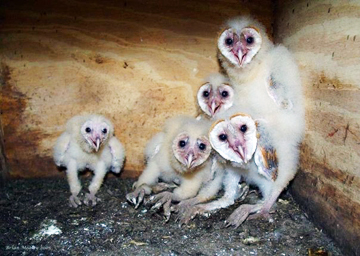 Photo ©
Brian Mealey
Photo ©
Brian Mealey
The Sweet Life of Barn Owls
Down in the sugarcane fields of the Everglades Agricultural Area (EAA), Barn Owls are just beginning their fall nesting attempts. Here, Barn Owl densities are among the highest in the world, and a thriving nest box program is partially responsible for this success. We asked Dr. Richard Raid of the Everglades Research and Education Center, University of Florida (Belle Glade), just what makes life so sweet for Barn Owls in the EAA. According to Dr. Raid, during most of the year rodents that live in the sugarcane fields provide the owls with an almost unlimited source of food. These rodents can cause massive damage to crops, so the owls help growers by removing some of these pests. The owls can raise two broods per year, corresponding with the cycles of sugarcane harvest. With the owls’ unusually large brood size of 4-8 chicks per nesting attempt, and each chick capable of eating one and a half times its weight in prey per day, it’s easy to see why growers might be sweet on these handsome owls.
If you would like to encourage Barn Owls to nest in your area, Dr. Raid offers some suggestions. First, start by putting up a Barn Owl nesting box in appropriate open habitat (i.e., sparse trees, low vegetation). You can mount it in a barn or silo, ideally in a structure with at least two exit routes. You can also mount it on an 8-10′ free-standing pole, preferably facing north to reduce the amount of daylight in the box. To sweeten the deal, add a predator guard to the pole. Nest boxes will be colonized more rapidly if placed in areas with existing owl populations, so if you don’t live in a rural area, talk to a local farmer or rancher about maintaining a box on their land. Finally, prevent bees and wasps from colonizing the box by applying a thin layer of bar soap on the inside surface of the roof. You can help us track the nesting success of Barn Owls by registering your boxes and monitoring nests with NestWatch.
 Photo ©
Photo ©